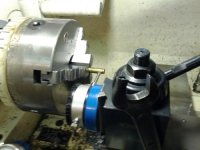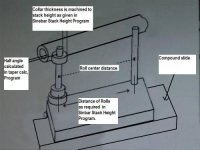JonathanK
New member
Here is how I have been setting up to taper bore. I use a thin sheet of brass between the the case and chuck, I lightly tighten the chuck with the case neck side in gripping a little of the case body. This leaves enough movement of the case for me to dial it in and be steardy enough to indicate the case length wise. I dial the case in using a couple places on the case to insur that its true. I then set the compound closw to 1 degree and run the indicator atached to the tool post on my compound and turn the compound (little by little .001 or so at a time using my wrench and sofly tapping the compound with one screw on the compound lightly tightened). Once I find where I can run the compound in and out with the indicator staying on 0 or not moving, this should be a good setting for taper boring that perticular case. An other thing I found ou is that my 0 on my compound is a tadoffon my Chinese machine, I chuck up a piece of work and cut it true for a length of 1.5 in. I then use my indicator o n my toolpost and run it the length of my work and find where the indicator doesnt move by adjusting the compound. This seems like the true 0 setting for,my compound. I thought Id run it by you guys before I scribe a new 0 on my machine. Also Im sure you guys know of better ways to set up the compound for taper boring....any help or info or opinions would be greatly appreciated !!!!
Thanks,
Jonathan Kuykendall
Thanks,
Jonathan Kuykendall



